Identification of Source Water Mixing in the Fish Slough Spring Complex, Mono County, California, USA
Abstract
:1. Introduction
Previous Studies
- An early reconnaissance phase during the early to mid-decades of the twentieth century, conducted to understand the regional geology, along with a focused evaluation of the Fish Slough area as a potential reservoir site.
- Investigations related to development of a water resource available for export out of the Owens Valley groundwater basin that were based on historical literature review and hydrologic modeling, with no Fish Slough-specific field work.
- Efforts in recent decades to comprehensively document and understand Fish Slough and causes for the declining flow of the spring.
2. Materials and Methods
3. Results
3.1. Geologic Framework
3.2. Hydrogeology
3.3. Geochemistry and Isotopic Composition
3.3.1. Adobe Valley Area
- River Spring (at two spring vents)
- Antelope Spring
- “Michelle Spring” (Black Lake vicinity)
- “Browner Spring” (Black Lake vicinity)
3.3.2. Benton Hot Springs Area
3.3.3. Additional Northern Areas
3.3.4. Tri-Valley Basin Fill
3.3.5. Fish Slough Springs
4. Discussion
- Northeast Spring is from a regional water source, deriving part of its water from the alluvial Tri-Valley groundwater system. This conclusion is based on
- general chemistry similarity to the Ca-HCO3 water type identified in the Tri-Valley area alluvial basins which differs significantly from the Na-HCO3 waters identified in the Benton Hot Springs and the Adobe Valley springs;
- stable isotope ratios are similar to those identified in the Tri-Valley area and separated from BLM and Northwest Springs; and
- the presence of 3H indicating that the spring water has a composite post-1950 age similar to that identified in the Tri-Valley groundwater system.
- Northwest and BLM Springs are regionally derived and are a possible mixture of more sodic sources to the north (Adobe Valley and Benton Hot Springs area) and northwest (Volcanic Tablelands), mixing with Fish Slough Northeast Spring/Tri-Valley water. This conclusion is based on
- general chemistry similarity to Tri-Valley water but with increasing sodium content with increased distance from Northeast Spring and trending toward the more volcanically-derived chemistry of the Adobe Valley waters;
- stable isotope ratios mid-range between Tri-Valley basin-fill groundwater and groundwater in the Adobe Valley/Benton Hot Springs area; and
- absence of 3H, potentially indicative of a longer flow path or dilution of tritium-bearing water from Northeast Springs to nondetectable values from non-3H-bearing groundwater from the northwest.
- Source water mixing combines two key source areas that feed the Fish Slough springs. These waters mix downgradient from Northeast Spring. In this area, transitional geochemical conditions and the diluting out of 3H that is observed at Northeast Spring (and absent from BLM and Northwest Spring) occurs.
- regularly resampling of springs to evaluate seasonal changes in geochemical characteristics in Fish Slough spring geochemistry;
- regular monitoring and maintenance of flow gauges and channels is recommended to collect accurate data and minimize erroneous measurements;
- radiocarbon analysis of spring discharge to further assess rates of groundwater movement;
- additional surface water, spring water, or groundwater sampling from existing wells in the vicinity of Fish Slough, to further refine the chemical characteristics and pathways of regional waters;
- additional hydraulic characterization of the system including installation of monitoring wells (potentially screened both in and below the Bishop Tuff) in the Fish Slough and the Hammil/Chalfant Valley area to monitor groundwater levels in conjunction with spring flow monitoring; and
- development of a numerical model of the Tri-Valley and Fish Slough areas as a water management tool for the Tri-Valley/northern Owens Valley.
Supplementary Materials
Author Contributions
Funding
Acknowledgments
Conflicts of Interest
References
- Kresic, N. Types and Classification of Springs. In Groundwater Hydrology of Springs: Engineering, Theory, Management, and Sustainability; Butterworth-Heinemann (Elsevier): Burlington, NJ, USA, 2010; pp. 31–86. [Google Scholar]
- Knopf, A.; Kirk, E. A Geologic Reconnaissance of the Inyo Range and the Eastern Slope of the Southern Sierra Nevada, California; U.S. Geological Survey Professional Paper 110; U.S. Geological Survey: Reston, VA, USA, 1918; 130p.
- Bateman, P. Geology and Tungsten Mineralization of the Bishop District, California; U.S. Geological Survey Professional Paper 470; U.S. Geological Survey: Reston, VA, USA, 1965.
- California Department of Water Resources. Fish Slough Dam and Reservoir: Feasibility Investigation; California Department of Water Resources Bulletin No. 126; California Department of Water Resources: Sacramento, CA, USA, 1964; 62p.
- University of California. Biotic Inventory and Ecosystem Characterization for Fish Slough, Inyo and Mono Counties, California; Grant Report Prepared for State of California Resources Agency, Department of Fish and Game: Sacramento, CA, USA, 15 June 1991.
- Danskin, W.R. Evaluation of the Hydrologic System and Selected Water-Management Alternatives in the Owens Valley, California; U.S. Geological Survey Water-Supply Paper 2370-H; U.S. Geological Survey: Reston, VA, USA, 1998; 175p.
- Hollett, K.J.; Danskin, W.R.; McCaffrey, W.F.; Walti, C.L. Geology and Water Resources of Owens Valley, California; U.S. Geological Survey Water-Supply Paper 2370-B; U.S. Geological Survey: Reston, VA, USA, 1991; pp. B1–B77.
- Chapman, J. Stable Isotope Investigation of the Source Water for the Fish Slough Springs, California; Letter Report: Division of Hydrologic Sciences; Desert Research Institute: Reno, NV, USA, 2002; 9p. [Google Scholar]
- United States Geological Survey. National Water Information Service (NWIS). 2018. Available online: https://maps.waterdata.usgs.gov/mapper/index.html (accessed on 30 June 2018).
- Jayko, A.S. Fish Slough, a Geologic and Hydrologic Summary, Inyo and Mono Counties, California; U.S. Geological Survey Administrative Report Prepared for BLM Bishop Field Office; U.S. Geological Survey: Reston, VA, USA, 2010; 30p.
- California Department of Fish and Wildlife. Fish Slough Vegetation Map; California Department of Fish and Wildlife: Sacramento, CA, USA, 2014.
- Andy Zdon & Associates, Inc. Mojave Desert Springs and Waterholes: Results of the 2015–2016 Mojave Desert Spring Survey, Inyo, Kern, San Bernardino and Los Angeles Counties, California; Andy Zdon & Associates, Inc.: Lafayette, CA, USA, 2016. [Google Scholar]
- Zdon, A.; Davisson, M.L.; Love, A.H. Testing the Established Hydrogeologic Model of Source Water to the Amargosa River Basin, Inyo and San Bernardino Counties, California. Environ. Forensics 2015, 16, 334–355. [Google Scholar] [CrossRef]
- Zdon, A.; Davisson, M.L.; Love, A.H. Understanding the source of water for selected springs within Mojave Trails National Monument, California. Environ. Forensics 2018, 19, 99–111. [Google Scholar] [CrossRef]
- Hildenbrand, T.G.; Briesacher, A.; Flanagan, G.; Hinze, W.J.; Hittelman, A.M.; Keller, G.R.; Kucks, R.P.; Plouff, D.; Roest, W.; Seeley, J.; et al. USGS Open File Report 02-463 “Rationale and Operational Plan to Upgrade the U.S. Gravity Database”. 2002. Available online: https://research.utep.edu/default.aspx?tabid=37229 (accessed on 20 February 2016).
- Pakiser, L.C.; Kane, M.F.; Jackson, W.H. Structural Geology and Volcanism of Owens Valley Region, California—A Geophysical Study; USGS Professional Paper 438; USGS: Reston, VA, USA, 1964.
- California Geological Survey. California Geomorphic Provinces. California Geological Survey Note 36; California Geological Survey: Sacramento, CA, USA, 2002; 4p.
- Calclim. California Climate Data Network. 2018. Available online: https://calclim.dri.edu/ (accessed on 30 June 2018).
- Los Angeles Department of Water and Power. Totals and Means Report; Los Angeles Department of Water and Power: Los Angeles, CA, USA, 2018.
- Parmenter, S.; California Department of Fish and Wildlife. Personal communications, 2018.
- Mariner, R.H.; Presser, T.S.; Evans, W.C. Geochemistry of Active Geothermal Systems in the Northern Basin and Range Province; Geothermal Resources Council Special Report No. 13; Geothermal Resources Council: Olympia, WA, USA, 1983. [Google Scholar]
- Kendall, C.; McDonnell, J.J. Isotope Tracers in Catchment Hydrology; Elsevier: Amsterdam, The Netherlands, 1998; 839p. [Google Scholar]
- Hem, J.D. Study and Interpretation of the Chemical Characteristics of Natural Water; U.S. Geological Survey Water-Supply Paper 2254; U.S. Geological Survey: Reston, VA, USA, 1985; 263p.
- California Department of Water Resources. Adobe Lake Valley Groundwater Basin, in California’s Groundwater; California Department of Water Resources Bulletin 118; California Department of Water Resources: Sacramento, CA, USA, 2004.
- Garside, L.J.; Schilling, J.H. Thermal Waters of Nevada; Nevada Bureau of Mines and Geology Bulletin 91; Nevada Bureau of Mines and Geology: Reno, NV, USA, 1979; 163p. [Google Scholar]
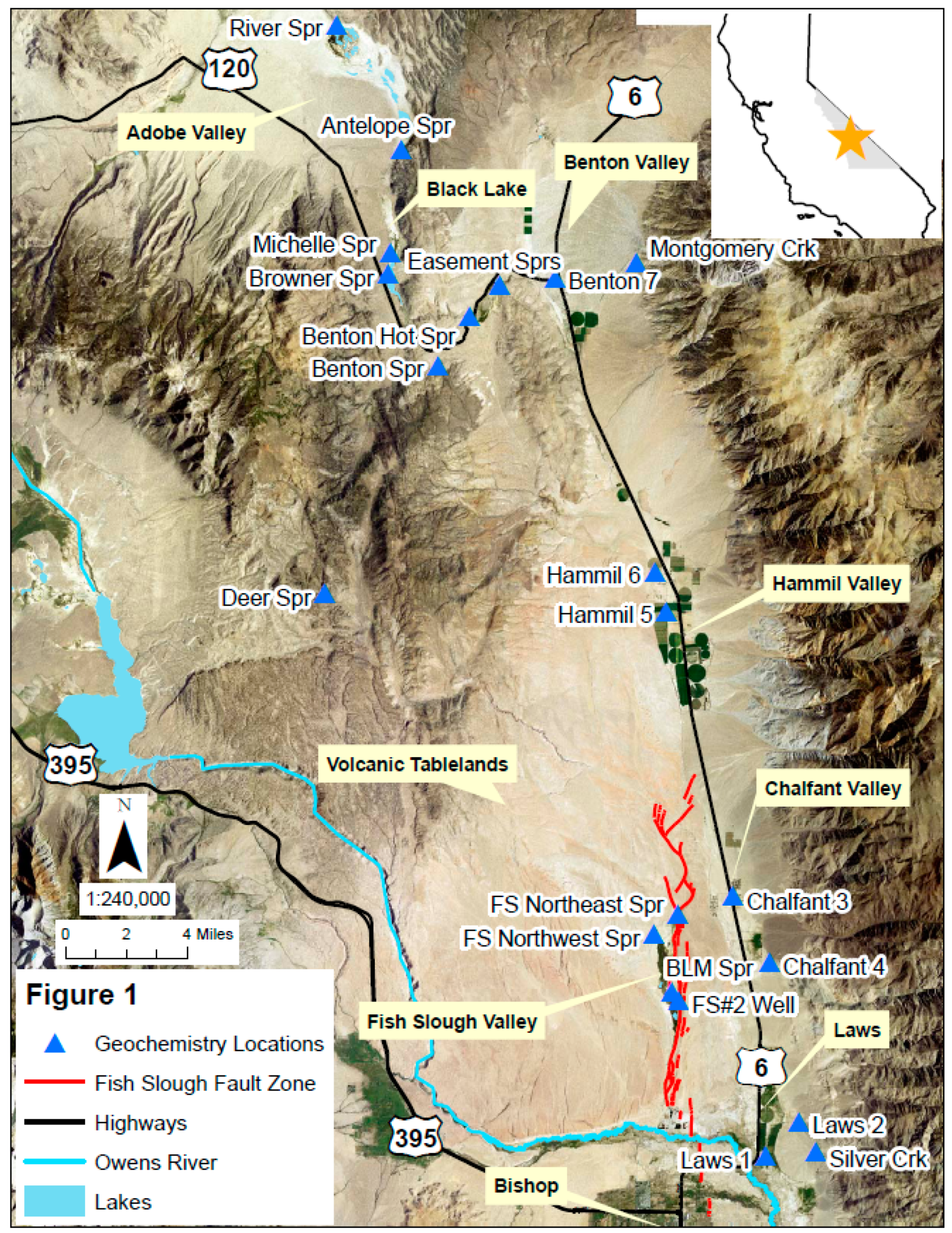
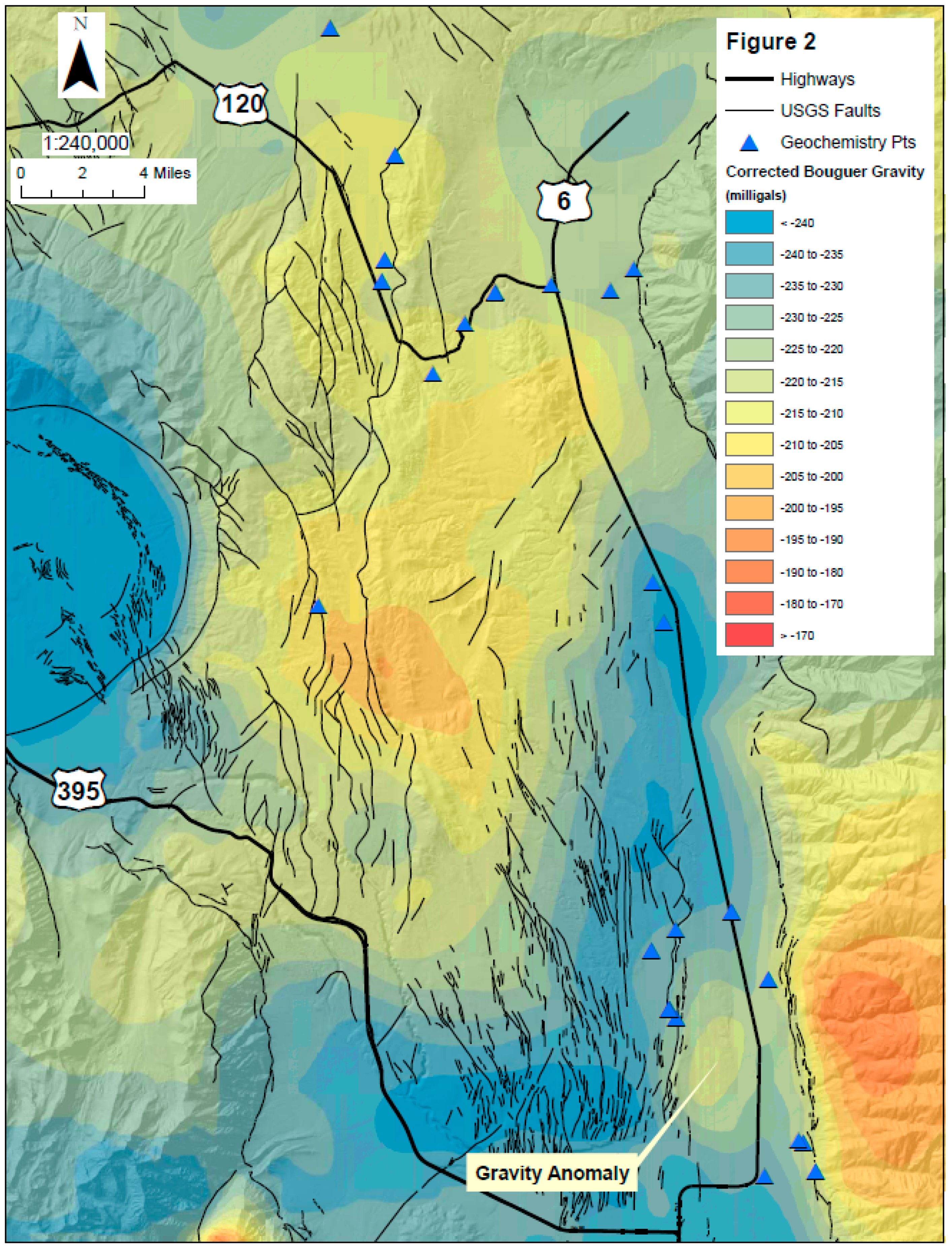
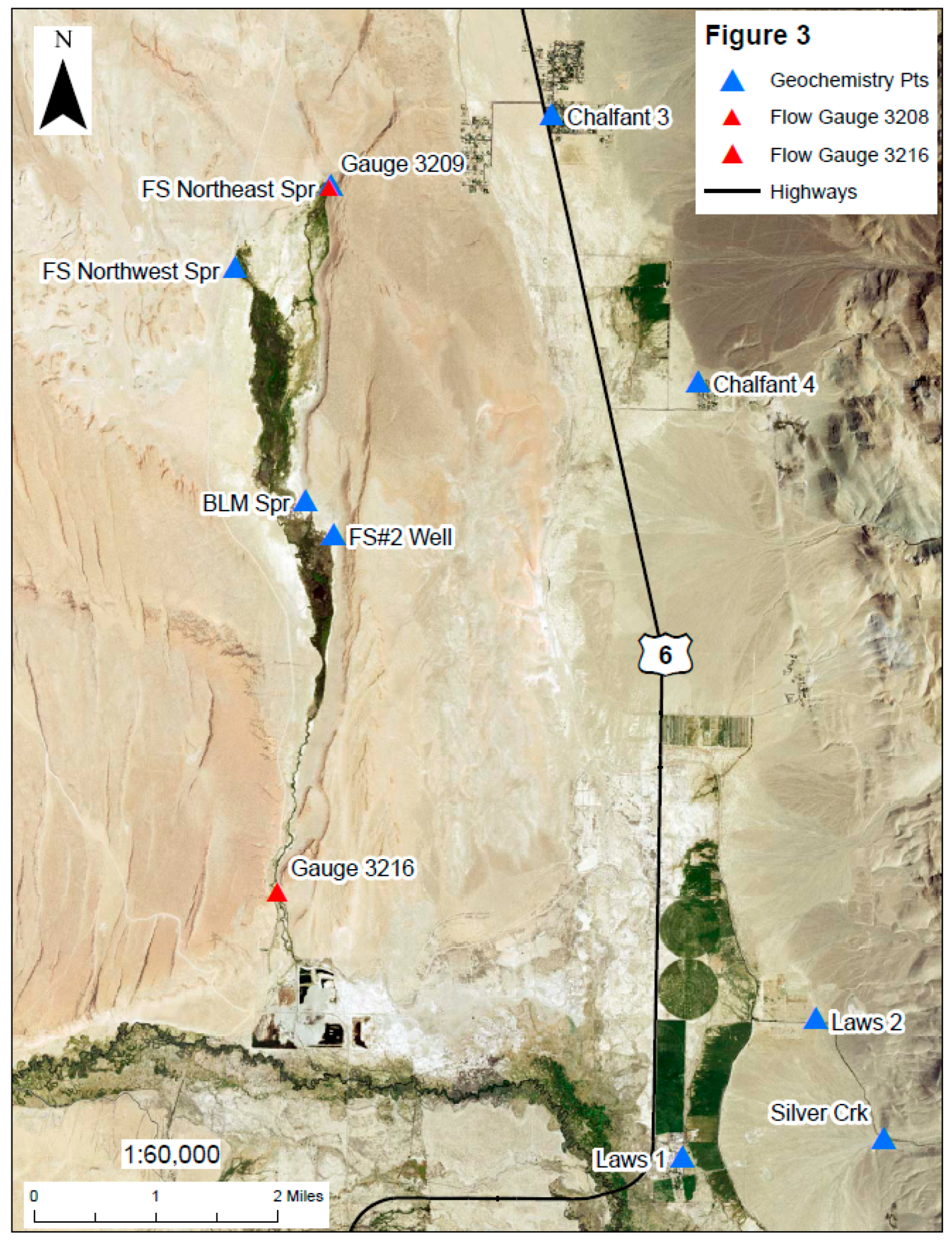
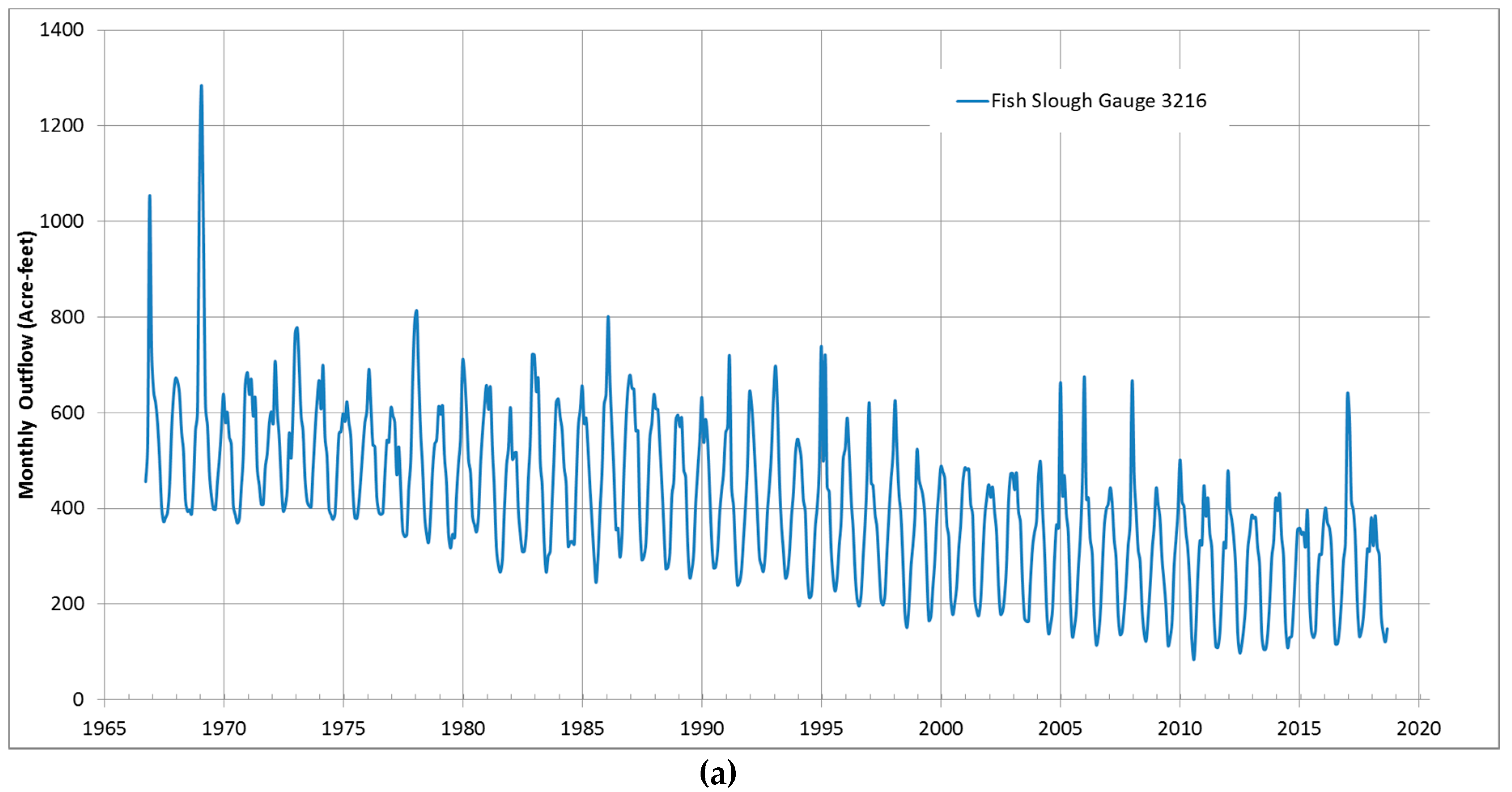

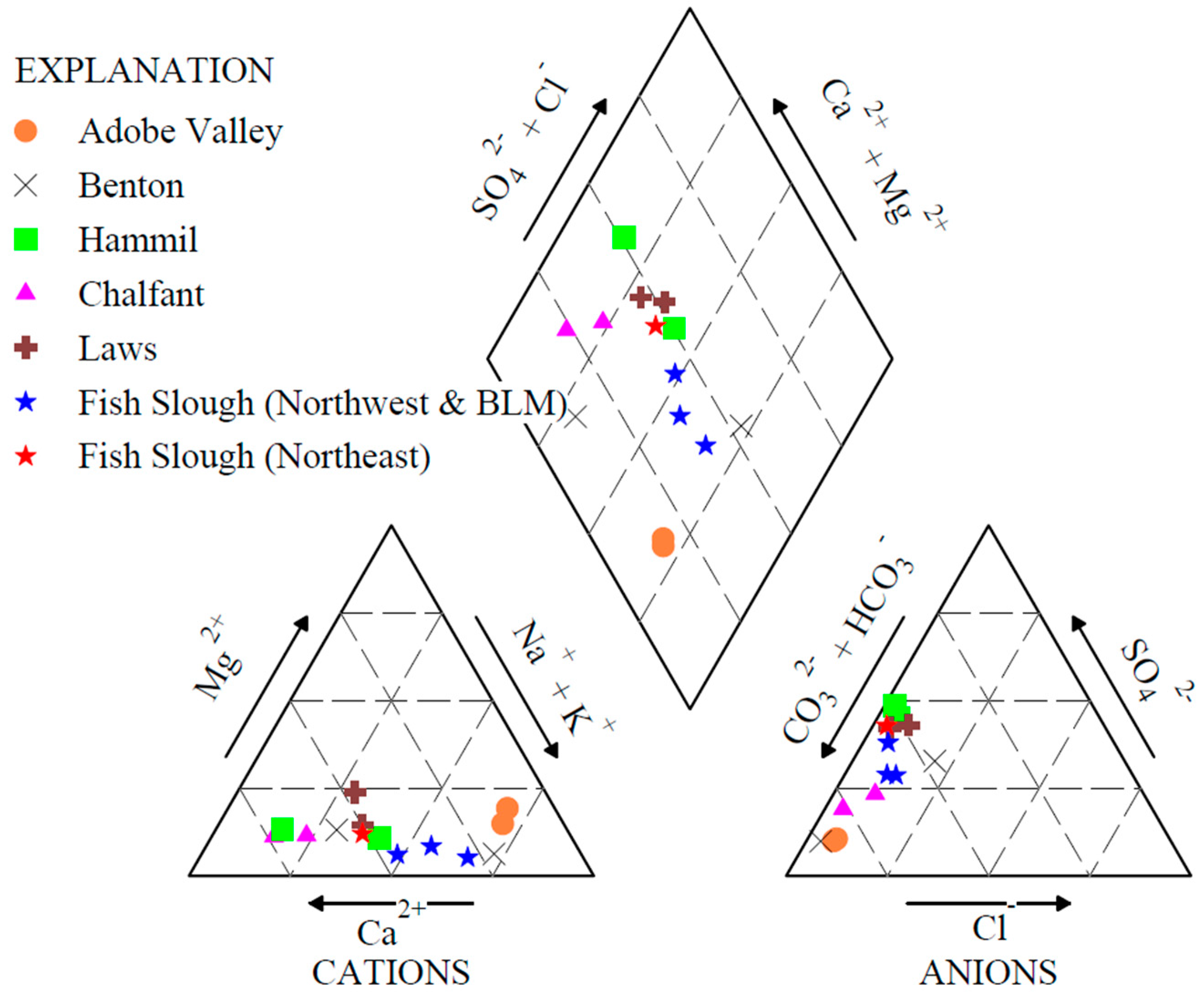

| Feature | Date | Owner | Latitude (1) | Longitude (1) | Elev (ft msl) | pH | Temperature (deg C) | Conductivity (ƒÊS) | TDS (ppm) | Dis. Oxygen (mg/L) | dD | d18O | 3H (NTU) |
|---|---|---|---|---|---|---|---|---|---|---|---|---|---|
| Fish Slough Area | |||||||||||||
| BLM Spring | 3/15/2017 | BLM | 37.48044 | −118.40324 | 4195 | 7.66 | 20 | 436 | 219 | 3.06 | −126.7 | −16.35 | ND<0.6 (5) |
| BLM Spring (Upper Vent) | 3/15/2017 | BLM | 37.48059 | −118.40329 | 4195 | 7.80(2) | 20.9 | 507 | 252 | 4.06 | −126.5 | −16.37 | ND<0.6 |
| BLM Spring (Linear Vent) | 3/15/2017 | BLM | 37.48031 | −118.40260 | 4195 | 8.03 | 22.4 | 509 | 255 | 3.5 | −124.7 | −16.27 | NA (3) |
| FS Northeast Spring (NE Spring) | 6/10/2017 | LADWP | 37.51793 | −118.40016 | 4217 | 7.89 | 21.6 | 384 | 191 | 0.93 | −122.8 | −16.25 | 0.76 (+/−0.25) |
| FS Northwest Spring (NW Spring) | 6/10/2017 | LADWP | 37.50801 | −118.41431 | 4203 | 7.89 | 20.3 | 356 | 178 | 2.46 | −124.9 | −16.20 | NA |
| Fish Slough Well #2 | 3/15/2017 | LADWP | 37.47654 | −118.39893 | 4186 | 7.79 | 11.7 | 535 | 266 | 2.54 | −121.7 | −15.97 | <0.71 |
| Adobe Valley/Benton Range | |||||||||||||
| River Spring | 3/14/2017 | BLM | 37.93850 | −118.61340 | 6496 | 8.14 | 16.7 | 195 | 98 | 3.67 | −132.5 | −17.34 | <0.6 |
| River Spring (Dock Vent) | 3/16/2017 | BLM | 37.93850 | −118.61340 | 6496 | 8.23 | 16.9 | 190 | 95 | 2.68 | −132.5 | −17.37 | NA |
| Antelope Spring | 3/14/2017 | BLM | 37.87929 | −118.57342 | 6494 | 8.09 | 15 | 238 | 122 | 3.03 | −132.0 | −17.28 | <0.65 |
| Deer Spring | 4/20/2017 | INF | 37.66747 | −118.61458 | 7290 | 7.07 | 9.2 | 222 | 111 | 3.46 | −119.9 | −15.64 | 2.27 |
| “Michelle Spring” | 4/20/2017 | ESLT | 37.83012 | −118.57882 | 6425 | 7.68 | 12.2 | 186 | 94 | 1.72 | −132.7 | −17.36 | NA |
| “Browner Spring” | 4/20/2017 | ESLT | 37.82000 | −118.58013 | 6430 | 7.64 | 25 | 470 | 226 | 1.31 | −115.0 | −14.57 | NA |
| Unnamed (UN) #1 (W of Black Lake) | 3/14/2017 | BLM | 37.80527 | −118.60192 | 7171 | NM | NM (4) | NM | NM | NM | NM | NM | NA |
| Unnamed (UN) #3 (SW of Benton HS) | 3/16/2017 | BLM | 37.77710 | −118.54913 | 6209 | 7.02 | 8.8 | 89 | 45 | 5.25 | −117.9 | −15.30 | NA |
| Easement South Spring | 4/21/2017 | Private | 37.81525 | −118.51291 | 5550 | 7.44 | 17.9 | 427 | 213 | 3.09 | −131.8 | −16.68 | <0.52 |
| Easement North Spring | 4/21/2017 | Private | 37.81580 | −118.51267 | 5545 | 7.22 | 16.9 | 469 | 235 | 1.43 | −131.1 | −16.57 | NA |
| Benton Hot Springs | 1977 | Private | Coordinates not provided in report | 9.32 | 56.5 | NM | NM | NM | −135.5 | −17.46 | NA | ||
| White Mountain Creeks | |||||||||||||
| Montgomery Creek-Lower | 3/14/2017 | BLM | 37.81729 | −118.44451 | 5875 | 7.92 | 10.4 | 166 | 83 | 7.42 | −116.8 | −15.62 | NA |
| Montgomery Creek-Upper | 3/14/2017 | BLM | 37.82767 | −118.43083 | 6441 | 7.78 | 8.1 | 164 | 82 | 10.31 | −117.5 | −15.70 | NA |
| Silver Creek-Lower | 3/14/2017 | BLM | 37.41891 | −118.32289 | 4200 | 7.96 | 8.1 | 412 | 205 | 13.3 | −125.9 | −16.52 | NA |
| Silver Creek-Upper | 3/14/2017 | BLM | 37.40554 | −118.31546 | 4416 | 6.81 | 10.3 | 75 | 37 | 13.28 | −126.0 | −16.56 | NA |
| Tri−Valley GAMA Wells | |||||||||||||
| “GAMA#1”-Laws 1 | 10/5/2006 | 37.40308 | −118.34547 | 4122 | 7.5 | 17.5 | 816 (sp.cond) | NM | 5.5 | −120 | −15.82 | 0.59 | |
| “GAMA#2”-Laws 2 | 8/23/1978 | 37.41972 | −118.32583 | 4185 | NM | 34 | 430 | NM | NM | −124 | −16.46 | 1.09 | |
| “GAMA#3”-Chalfant 3 | 10/5/2006 | 37.52683 | −118.36722 | 4256 | 7.7 | 17.5 | 364 | NM | 7 | −121 | −16.07 | 0.09 | |
| “GAMA#4”-Chalfant 4 | 9/11/2006 | 37.49536 | −118.34481 | 4265 | NM | NM | NM | NM | NM | −126 | −16.86 | 0.5 | |
| “GAMA#5”-Hammil 5 | 10/2/2006 | 37.66175 | −118.40953 | 4550 | 7.9 | 15 | 275 | NM | 8.4 | −122 | −16.39 | 0.59 | |
| “GAMA#6”-Hammil 6 | 10/2/2006 | 37.68067 | −118.41683 | 4590 | 7.8 | 17 | 404 | NM | NM | −122 | −16.03 | 0.5 | |
| “GAMA#7”-Benton 7 | 10/5/2006 | 37.81961 | −118.47953 | 5380 | 7.4 | 15 | 372 | NM | 5.2 | −121 | −16.10 | 0.09 | |
© 2019 by the authors. Licensee MDPI, Basel, Switzerland. This article is an open access article distributed under the terms and conditions of the Creative Commons Attribution (CC BY) license (http://creativecommons.org/licenses/by/4.0/).
Share and Cite
Zdon, A.; Rainville, K.; Buckmaster, N.; Parmenter, S.; Love, A.H. Identification of Source Water Mixing in the Fish Slough Spring Complex, Mono County, California, USA. Hydrology 2019, 6, 26. https://doi.org/10.3390/hydrology6010026
Zdon A, Rainville K, Buckmaster N, Parmenter S, Love AH. Identification of Source Water Mixing in the Fish Slough Spring Complex, Mono County, California, USA. Hydrology. 2019; 6(1):26. https://doi.org/10.3390/hydrology6010026
Chicago/Turabian StyleZdon, Andy, Keith Rainville, Nicholas Buckmaster, Steve Parmenter, and Adam H. Love. 2019. "Identification of Source Water Mixing in the Fish Slough Spring Complex, Mono County, California, USA" Hydrology 6, no. 1: 26. https://doi.org/10.3390/hydrology6010026
APA StyleZdon, A., Rainville, K., Buckmaster, N., Parmenter, S., & Love, A. H. (2019). Identification of Source Water Mixing in the Fish Slough Spring Complex, Mono County, California, USA. Hydrology, 6(1), 26. https://doi.org/10.3390/hydrology6010026





